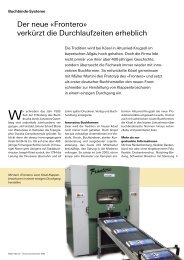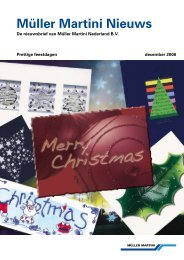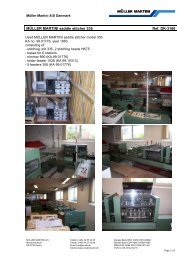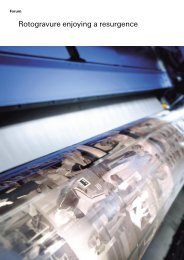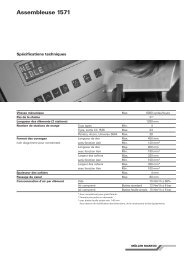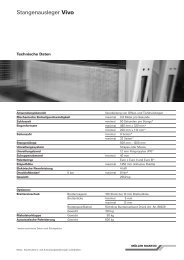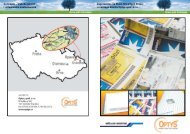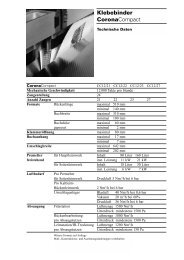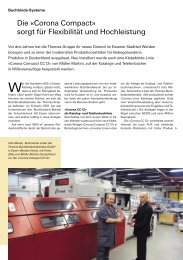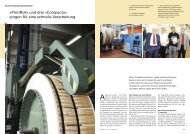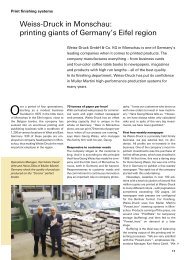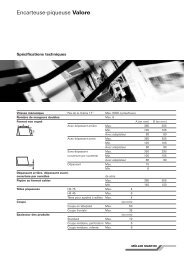“The mailroom lies at the heart of newspaper production”
“The mailroom lies at the heart of newspaper production”
“The mailroom lies at the heart of newspaper production”
Create successful ePaper yourself
Turn your PDF publications into a flip-book with our unique Google optimized e-Paper software.
Mailroom systems<br />
1<br />
<strong>“The</strong> <strong>mailroom</strong> <strong>lies</strong> <strong>at</strong> <strong>the</strong><br />
<strong>heart</strong> <strong>of</strong> <strong>newspaper</strong> <strong>production”</strong><br />
Kieler Nachrichten produces no fewer than 40 different<br />
<strong>newspaper</strong> titles and advertising papers. Three new<br />
“NewsLiner-A/D” inserting lines and a “FlexiRoll” buffer<br />
system from Muller Martini ensure optimum interaction<br />
between press and <strong>mailroom</strong>.<br />
2<br />
1 Most impressive: <strong>the</strong> new <strong>mailroom</strong><br />
<strong>of</strong> <strong>the</strong> “Kieler Nachrichten” with three<br />
“NewsLiner-A/D” inserting lines, nine<br />
“NewsStack” compens<strong>at</strong>ing stackers<br />
each with TABA route address sheet<br />
applic<strong>at</strong>ion, and three “FlexiRoll” buffer<br />
systems.<br />
In January 2003, while moving to new<br />
production facilities loc<strong>at</strong>ed outside <strong>the</strong><br />
g<strong>at</strong>es <strong>of</strong> <strong>the</strong> German city <strong>of</strong> Kiel <strong>the</strong><br />
“Kieler Nachrichten” decided to invest in<br />
a new <strong>mailroom</strong>. As <strong>newspaper</strong>s were still<br />
being produced on a competitor’s product<br />
in <strong>the</strong> old town <strong>of</strong> Kiel, <strong>the</strong> <strong>newspaper</strong><br />
printer was busy installing Muller Martini<br />
inserting and buffering systems.<br />
“We spent one and a half years working<br />
intensively on our new investment,” remembers<br />
Technical Manager, Michael<br />
Sulenski. “We drew up a 120-point list and<br />
deliber<strong>at</strong>ely involved our staff in <strong>the</strong> decision-making<br />
process.”<br />
Two evalu<strong>at</strong>ions – one result<br />
After an extensive evalu<strong>at</strong>ion procedure<br />
involving different suppliers, <strong>the</strong> staff<br />
came up with <strong>the</strong>ir own final report – quite<br />
independently <strong>of</strong> <strong>the</strong> management. And<br />
although <strong>the</strong>y were used to o<strong>the</strong>r systems,<br />
<strong>the</strong>y decided on <strong>the</strong> Muller Martini solution<br />
with three “NewsLiner-A/D” inserting<br />
lines, nine “NewsStack” compens<strong>at</strong>ing<br />
stackers each with TABA route address<br />
sheet applic<strong>at</strong>ion, and three “FlexiRoll”<br />
buffer systems.<br />
According to Michael Sulenski, <strong>the</strong><br />
management were in complete agreement<br />
with <strong>the</strong> workforce: “From both<br />
technical and economic standpoints, we<br />
2 Apart from three regional editions<br />
<strong>of</strong> <strong>the</strong> main <strong>newspaper</strong>, <strong>the</strong> “Kieler<br />
Nachrichten” also produces 40 o<strong>the</strong>r<br />
titles, including <strong>the</strong> “Hamburger<br />
Morgenpost”.<br />
came to <strong>the</strong> same conclusion as our staff.<br />
Apart from <strong>the</strong> linear construction and<br />
<strong>the</strong> option <strong>of</strong> two-up production (80,000<br />
copies), <strong>the</strong> easy handling <strong>of</strong> <strong>the</strong> infeed<br />
A <strong>newspaper</strong> with<br />
a tradition<br />
The “Kieler Nachrichten” – independent<br />
provincial <strong>newspaper</strong> for Schleswig-Holstein,<br />
is <strong>the</strong> only daily published in <strong>the</strong><br />
provincial capital, Kiel. The first issue under<br />
<strong>the</strong> current name was published on 3<br />
April 1946. It resulted from <strong>the</strong> merger <strong>of</strong><br />
<strong>the</strong> “Kieler Zeitung” (founded in 1864) and<br />
<strong>the</strong> “Kieler Neuesten Nachrichten” (founded<br />
in 1894).<br />
100 permanent members <strong>of</strong> staff and<br />
500 temporaries work seven days a week<br />
(only <strong>the</strong> early shift on S<strong>at</strong>urdays and <strong>the</strong><br />
morning and midday shifts on Sundays are<br />
not worked) in <strong>the</strong> new, three-storey printing<br />
center outside <strong>the</strong> g<strong>at</strong>es <strong>of</strong> this city<br />
with a maritime tradition.<br />
The company is 51% owned by Christian<br />
Heinrich, 24.5% by <strong>the</strong> Axel Springer<br />
publishing company and 24.5% by <strong>the</strong><br />
Hanse<strong>at</strong>ische Verlagsbeteiligungsgesellschaft<br />
(Hanse<strong>at</strong>ic Publishers Associ<strong>at</strong>ed<br />
Company).<br />
7<br />
�
3 Preprinted sections and advertising<br />
supplements are printed in-house during<br />
<strong>the</strong> day shift and <strong>the</strong>n autom<strong>at</strong>ically fed<br />
to <strong>the</strong> inserting lines in <strong>the</strong> evening.<br />
4 Michael Sulenski in front <strong>of</strong> <strong>the</strong><br />
“NewsStack“: <strong>“The</strong> ‘Kieler Nachrichten’<br />
is very bulky because <strong>of</strong> extensive<br />
regional coverage.“<br />
st<strong>at</strong>ions (setup times) came out in favor <strong>of</strong><br />
<strong>the</strong> ‘NewsLiner-A/D’.”<br />
Zoning <strong>the</strong> “Kieler Nachrichten”...<br />
A well organized <strong>mailroom</strong> is especially<br />
important for this media company, as it<br />
produces no fewer than 40 <strong>newspaper</strong>s<br />
– both dai<strong>lies</strong> and advertising papers. Inhouse<br />
title, <strong>the</strong> “Kieler Nachrichten”, with<br />
a circul<strong>at</strong>ion <strong>of</strong> 110,000 copies during <strong>the</strong><br />
week and 130,000 copies on S<strong>at</strong>urdays<br />
and one <strong>of</strong> <strong>the</strong> leading <strong>newspaper</strong>s in <strong>the</strong><br />
north German province <strong>of</strong> Schleswig-Holstein,<br />
appears in three regional editions for<br />
Plön, Eckernförde and Neumünster.<br />
“Our <strong>newspaper</strong> is very bulky because<br />
<strong>of</strong> <strong>the</strong> extensive regional coverage,” says<br />
Michael Sulenski. The regional sections<br />
with four to eight pages are inserted into<br />
3<br />
4<br />
a 32-page jacket (64 pages <strong>at</strong> <strong>the</strong> weekend)<br />
using <strong>the</strong> “NewsLiner-A/D”.<br />
. . . and <strong>the</strong> “Hamburger<br />
Morgenpost”<br />
However, <strong>the</strong> in-house <strong>newspaper</strong>s and<br />
advertising papers published make up<br />
only about 40% <strong>of</strong> <strong>the</strong> print volume. The<br />
majority <strong>of</strong> <strong>the</strong> titles are contract work<br />
from <strong>the</strong> Mecklenburg-Vorpommern and<br />
Hamburg conurb<strong>at</strong>ion. These include <strong>the</strong><br />
“Hamburger Morgenpost” which appears<br />
six times a week with a circul<strong>at</strong>ion <strong>of</strong><br />
140,000 copies.<br />
This full four-color tabloid <strong>newspaper</strong><br />
has three editions. At 7 o’clock in <strong>the</strong><br />
evening, a night edition with up to 5,000<br />
copies is printed for sale in pubs and bars.<br />
A mere half hour l<strong>at</strong>er, <strong>the</strong> n<strong>at</strong>ional edition<br />
follows which has a circul<strong>at</strong>ion <strong>of</strong> 12,000<br />
copies. And <strong>the</strong>n <strong>at</strong> 8:30 pm, <strong>the</strong> main<br />
edition goes to press.<br />
“With such tight time frames, it soon<br />
becomes apparent th<strong>at</strong> it is <strong>the</strong> <strong>mailroom</strong><br />
and not <strong>the</strong> press th<strong>at</strong> <strong>lies</strong> <strong>at</strong> <strong>the</strong> <strong>heart</strong> <strong>of</strong><br />
<strong>newspaper</strong> production,” Michael Sulenski<br />
tells us. Production structure is governed<br />
by <strong>the</strong> <strong>mailroom</strong>. Current technology<br />
makes it possible to keep <strong>newspaper</strong>s<br />
more up-to-d<strong>at</strong>e. But if <strong>the</strong> <strong>mailroom</strong> cannot<br />
keep up, <strong>the</strong> capital invested disappears<br />
in a puff <strong>of</strong> smoke.”<br />
“We are independent<br />
in <strong>the</strong> <strong>mailroom</strong>”<br />
The <strong>mailroom</strong> takes on all <strong>the</strong> more significance,<br />
as all three editions <strong>of</strong> <strong>the</strong> “Kieler<br />
Nachrichten” regularly contain preprinted<br />
sections – both editorial and<br />
commercial. So, for example, <strong>the</strong> three<br />
editions <strong>of</strong> <strong>the</strong> “Kieler Nachrichten” include<br />
<strong>the</strong> daily magazine “Heute” with<br />
events and TV programs, as well as a supplement<br />
on S<strong>at</strong>urdays with property, cars<br />
and situ<strong>at</strong>ions vacant.<br />
The preprinted sections and advertising<br />
supplements are printed in-house during<br />
<strong>the</strong> day, wound onto “FlexiRolls” for buffering<br />
and <strong>the</strong>n unwound again between 6<br />
and 9 o’clock in <strong>the</strong> evening when <strong>the</strong><br />
“Kieler Nachrichten” is printed. “This<br />
means we can oper<strong>at</strong>e our <strong>mailroom</strong> independently<br />
<strong>of</strong> <strong>the</strong> press, which we are able<br />
to run <strong>at</strong> full speed <strong>at</strong> all times. In addition,<br />
<strong>the</strong> autom<strong>at</strong>ed system helps us save on<br />
labor costs”, says Michael Sulenski. So<br />
only a few units <strong>of</strong>ten come in runs <strong>of</strong><br />
2,000 to 3,000 copies in split run editions,<br />
still have to be fed in by hand by casual<br />
staff who can be called in when needed.<br />
www.kn-online.de<br />
8 Muller Martini Panorama September 2004



